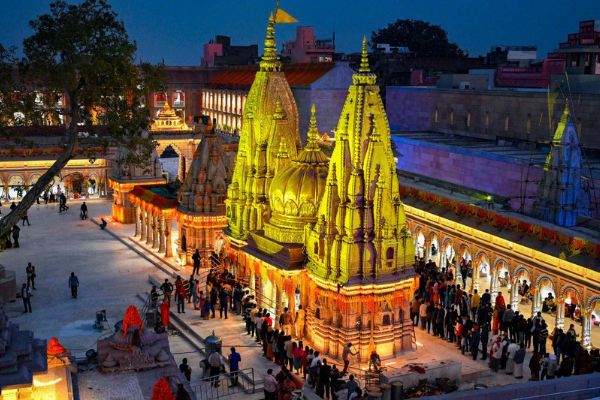Kashi Vishwanath Temple in Varanasi is a well-known Hindu temple dedicated to Lord Shiva, meaning of Vishvanatha is Ruler of The Universe. The temple is situated on the bank of the holy Ganga River in Varanasi, Uttar Pradesh, India. It is one of the 12 Jyotirlingas in India that are supposed to be the Lord Shiva’s most sacred abodes. The temple is considered a central part of worship in Shaiva culture by Hindu scriptures.
Varanasi is a holy city in India also known as Kashi and Banaras, A city of Moksha for Hindus since centuries that has seen the world turn, Varanasi which has been standing the tests of time for over 5,000 years is said to be one of the oldest inhabited cities in the world, and Varanasi is considered as one of the Best pilgrimage places to visit in India. Varanasi is older than history, older than the tradition, older even than the legend, the Holy City of Light Shines brightly for Hindus both physically and metaphorically It is believed a single dip in the holy waters of the Ganges can wash away a lifetime of sins.
Kashi Vishwanath Temple was destroyed and rebuilt many times throughout history. The most recent temple was destroyed by the sixth Mughal emperor Aurangzeb, after which he built a mosque on the site. The current Kashi Vishvanath Temple was built nearby in 1780 by the Maratha ruler Maharani Ahilyabai Holker. The Kashi Vishvanath Temple has been under state management since 1983; however, during the festival of Shivratri, Kashi Naresh will serve as the chief officiating priest.
Most famous ghats in varanasi
There are 84 ghats in Varanasi. Almost all of the ghats serve as destinations for bathing and puja rites, however there are two ghats of Manikarnika ghat and Harishchandra ghat, which are solely used for cremation. The history of ghats starts from the 14th century, however the majority of them were renovated in the 18th century under Maratha sponsorship. Morning and evening boat rides or walk along the ghats is a popular way to see Varanasi’s culture and spirituality.
Dashashwamedh Ghat: This is the major ghat where every evening the beautiful Ganga aarti ceremony takes place. It is also the most historic and active ghat, with several activities.
Manikarnika Ghat: This is the most important cremation ghat, and Hindus believe that dying or being burned here will free them from the cycle of rebirth. It is a dramatic and intense venue to see life and death rituals.
Assi Ghat: The southernmost ghat, where the Ganges joins the Assi. It is a popular destination for pilgrims, tourists, and locals to relax, shop, and attend the morning and evening aartis ceremony take place.
